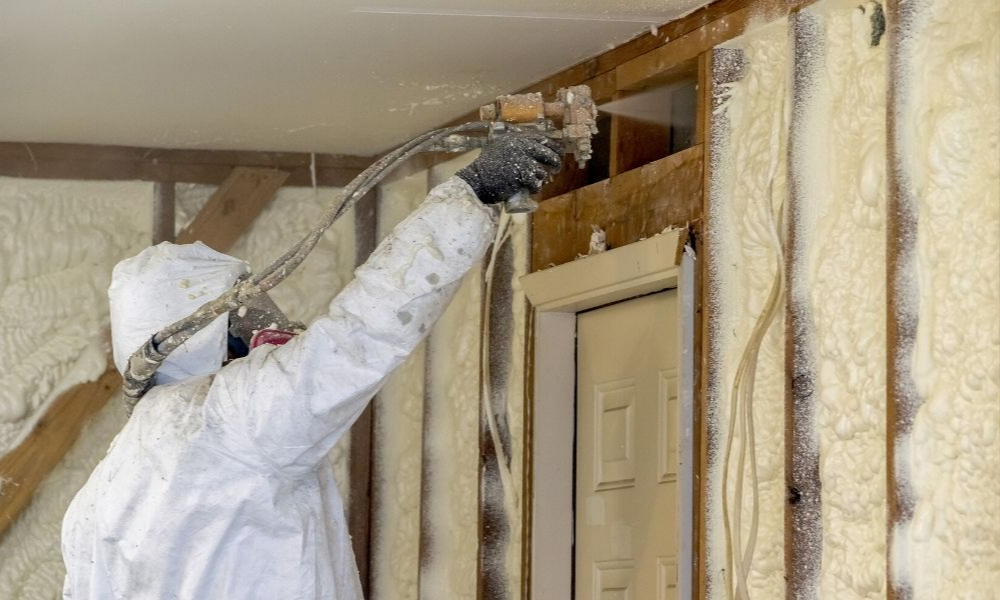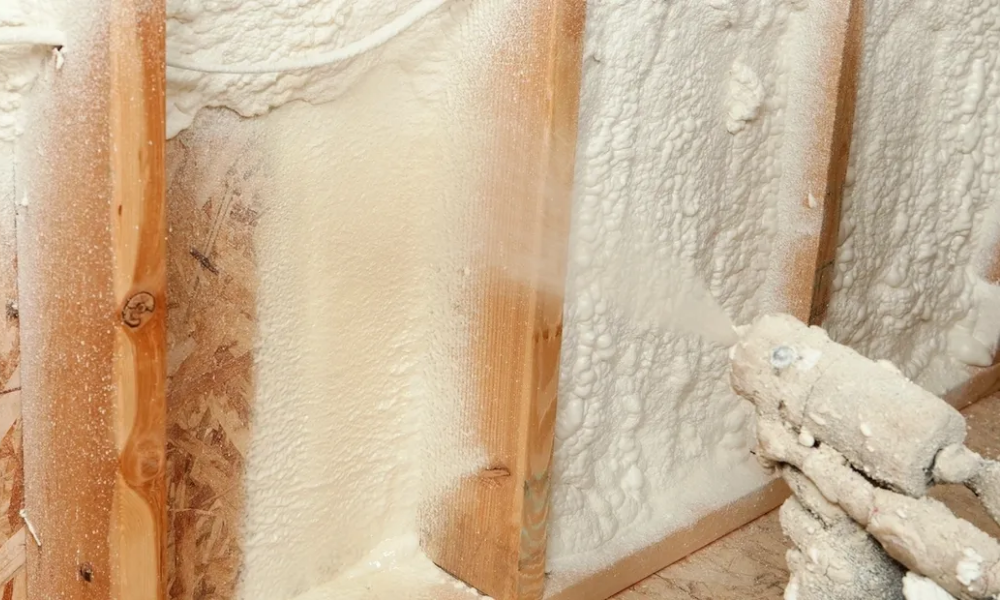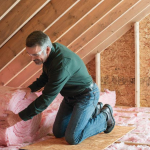When it comes to insulation, there are many options on the market. But if you want the best insulation money can buy, spray foam is the way to go. So how much does spray foam insulation cost?
Insulation is essential for keeping a home cool in the summer and warm in the winter. Nonetheless, different insulation products have variable heat reduction levels (R-values) and prices. Because spray foam insulation is dense and expands more than other types of insulation, it seals air gaps more effectively than other types of insulation, making it one of the finest solutions for insulating a home. It is, however, not the most affordable alternative.
Spray foam insulation can cost anywhere from $1,284 to $3,741 to install professionally, with a national average of $2,492. Spray foam insulation, unlike other types of insulation such as blown-in cellulose fibres or fibreglass batts, is not a do-it-yourself activity.
Determine whether spray foam insulation is appropriate for your property and what elements will affect the entire cost ahead of time.
What Is Spray Foam Insulation and How Does It Work?
Spray foam insulation is often made of a polyurethane-based liquid that expands when mixed with air to fit into stud walls, rafter, and joist spaces. Spray foam is an excellent sealer because it covers even the tiniest holes, preventing air leakage. You know how tough it is to efficiently heat and cool a house if you’ve ever lived with draughty windows. Energy bills rise due to the draughts, and comfort suffers as a result. Temperature fluctuations.
Spray foam insulation is the best possible solution for removing draughts and air leaks because it creates an airtight seal that will last for years to come. When applied correctly, it can also increase the strength of your walls by bonding with the framing.
Factors in Calculating Spray Foam Insulation Cost
Spray foam insulation is done in 1-inch thick layers, and the professionals who do it are pretty skilled at keeping the layers uniform, but a stud spacing is deeper than that. Nonetheless, determining the cost of spray foam insulation is straightforward.
- To calculate the area, multiply the width and height of the wall by two. A wall that is 10 feet broad and 8 feet high, for example, has an area of 80 square feet.
- Multiply the wall’s surface area by the stud space’s depth. The stud spacing will be 3.5 inches thick if the wall has 24 studs. You get 280 by multiplying 80 by 3.5. This is the total number of board feet that will be insulated using spray foam. A board foot is 12 inches long, 12 inches broad, and 1 inch thick, to give you an idea.
Filling the wall to a depth of 3.5 inches with open-cell spray foam insulation (see below) would cost $123 and $182. Filling the same 80-square-foot wall with closed cell spray foam insulation would cost $280 and $420. These figures are based on open-cell insulation costs ($0.44 to $0.65 per board foot) and closed-cell foam insulation costs ($1.00 to $1.50 per board foot).
Open-Cell vs. Closed-Cell Spray Foam Insulation Type and Thickness
While professional spray foam insulation installation costs typically range from $1,284 to $3,741, prices vary depending on the spray foam insulation used.
- Open Cell Spray Foam: Because the cells in this spray foam do not form complete encapsulations, the foam is softer and more flexible. Open-cell spray foam insulation costs $0.44 to $0.65 per board foot.
- Closed Cell: Like open-cell foam, closed-cell foam is made by mixing a polyurethane liquid with air, causing it to expand and plug gaps. Closed-cell insulating foam has encased air cells, as the name implies. This accomplishes two goals: It makes closed-cell foam denser and more moisture-resistant than open-cell foam. Closed-cell spray foam installation costs about $1.00 to $1.50 per board foot.
Installation Type, Labor, and Accessibility
The cost of labour to install spray foam insulation accounts for a significant amount of the total. Most spray foam insulation installers must be trained to install a particular brand of insulation and utilize a spray rig that the manufacturer specifies. Depending on the area, the labour element of the project costs around $50 to $100 per hour. Because labour costs aren’t significantly different depending on insulation, open-cell and closed-cell applications will have identical labour expenses.
Size of the Area
The size of the area to be insulated has a significant impact on the cost of the job. Spray foam insulation costs $44 to $150 on average for a small job with 100 square feet of wall that needs to be insulated. Most projects, however, are more significant, and homes with 3,000 square feet of wall space would cost between $1,320 and $4,500 to finish.
Geographical location
Spray foam insulation installation costs vary by area, depending on the number of companies providing the service, the demand, and average labour costs. The typical cost of spray foam insulation, for example, differs significantly in the following communities:
- Phoenix, Arizona: $2,240
- Austin, Texas: $2,840
- Chicago, Illinois: $1,780
- New York, New York: $2,560
Call at least three insulation firms and ask for estimates to get a better idea of what the cost would be in your region.
Additional Costs and Factors to Consider
When a new home is being built, the optimal time to install insulation is when the wall openings are open, and insulation is easiest to install. Because the locations are easily accessible, the labour expenses for spray foam insulation installation, which vary from $50 to $100 per hour, will be lower.
In an existing home, however, portions of the drywall may need to be removed to access the stud spaces, and specific installers may refuse to work on the project if the spaces are not visible. Spray foam insulation is intended to be placed in thin layers that expand to a thickness of one inch, and each layer should be thoroughly dried before proceeding to the next. The cost of insulating will be increased if drywall must be removed to have access to the stud and rafter areas.
Mould Remediation
Some types of insulation, such as fibreglass batts, can be damaged by moisture, as they tend to compress when wet and lose their insulating properties. Leaks inside wall cavities harm fibreglass insulation, but they can also lead to mould development, which must be cleaned before the wall space is insulated again.
Mould remediation costs range from $1,500 to $3,500, depending on the size of the space to be treated and the current labour rate in the area.
Installation of a Vapor Barrier
To prevent moisture from passing through exterior walls, specific municipal construction rules demand the installation of a vapour barrier. If this is the case, closed-cell spray foam insulation can be used as a vapour barrier. On the other hand, open-cell insulation is not a sound vapour barrier; therefore, if the homeowners prefer open-cell insulation, but the code requires a vapour barrier, an additional vapour barrier will be required, which may cost $0.65 to $1 per square foot.
What Are the Different Types of Spray Foam Insulation?
While polyurethane-based spray foam insulation is the most common and traditional, various types are available, including more environmentally friendly ones. Choosing a different type of spray foam is unlikely to change the installation cost. The majority of the price difference in spray foam installation is determined by the thickness of the product and the going labour cost in various localities.
Spray Foam Made of Polyurethane
The majority of spray foam insulation on the market today is polyurethane, which has an excellent insulating value but tends to off-gas after a few years. The release of volatile organic compounds (VOCs) that may generate a significant chemical odour is known as off-gassing. Off-gassing is at its peak in the first year following installation and should be completely gone in four to five years. Professional installation of polyurethane foam insulation will cost between $0.44 and $1.50 per board foot.
Spray Foam Insulation Made of Soybeans
Soybeans are farmed for various purposes, both food and non-food, one of which is as a component of spray foam insulation. Because soybean-based foam contains little or no VOCs, there is no unpleasant chemical odour that some homeowners may find bothersome.
Soybeans are a sustainable crop that can be planted and harvested continuously. Therefore individuals looking for an eco-friendly alternative to polyurethane-based insulation may wish to request a soybean-based solution. The size of the project will determine the entire cost; for example, insulating a 500-square-foot ceiling costs between $220 and $750, while a 2,500-square-foot project can cost up to $3,750.
Spray Foam Made of Water
For individuals looking for an alternative to polyurethane-based foam, water-based spray foam may be possible. It will cost about the same to have it placed, ranging from $0.50 to $2.50 per square foot, depending on whether it’s open-cell or closed-cell insulation. The project’s scale, as well as the going labour rate, are also factors to consider.
Spray Foam Insulation Using Vegetable Oil
While some spray foam insulation is labelled as being created from vegetable oil, almost all are still derived from soybean oil, which has specific properties that make it ideal for making a long-lasting insulating product. Although the price will be comparable to other foam forms, soy- and vegetable-based foams may not be available in all areas.
Spray Foam Insulation Can be Used in a Variety of Situations
Spray foam insulation can be beneficial in various locations of the home. It provides an airtight seal that can remove most sources of draughts and dampens sound transfer between rooms since it sprays on as a liquid and then expands to cover gaps. Spray foam insulation works well in the following areas:
- Exterior stud walls
- Interior walls if sound-dampening is desired
- Roof rafters, in conjunction with a radiant barrier (if desired) for the greatest R-value
- Crawl spaces
- House penetrations, such as vent pipes, water fixtures, and gas pipes
- Interior stud walls (for sound purposes)
Spray Foam Insulation Benefits
Insulating a home saves energy and helps homeowners maintain a suitable indoor climate. While there are many other types of insulation, spray foam is up to 50% more efficient than other varieties, such as fibreglass batts or cellulose fibres, because it also works as a sealer.
Reduced Utility Bills
Drafty windows and other sources of air leaking in and out of a home can cost up to 40% of a home’s energy bill. While all types of insulation will boost a home’s thermal resistance, only spray foam will seal air leaks, resulting in decreased utility expenditures. Spray foam insulation installation costs range from $1,284 to $3,741, which is more expensive than batts, but if you live in a location with high heating and cooling bills, it could pay for itself in a few years.
Moisture-Blocking and Air Sealing
Water that leaks through siding can damage a home’s wooden structure, so moisture and construction materials don’t mix. Closed-cell spray foam insulation, which costs $1,500 to $2,250 to insulate 1,500 board feet, is an adequate air sealer, but it also serves a role that open-cell foam doesn’t. Water is kept away from construction components using closed-cell foam as a moisture barrier.
Soundproofing
Spray foam insulation creates a solid layer between wall studs, providing excellent sound insulation. Close-cell and open-cell spray foam insulation can be put in wall cavities to limit sound transfer. It can be advantageous when used on exterior walls to help mask the sound of a busy roadway or on common walls between distinct living rooms in duplexes and apartment complexes. Spray foam insulation costs $2,492 on average to insulate an entire home.
High R-Value
Spray foam insulation has a higher thermal resistance than other types of insulation due to its density and sealing characteristics. The ability of a material to reduce heat and cold thermal transfer by one-inch thickness is measured by its R-value, and the R-value of closed-cell foam insulation is the highest.
- Closed-cell spray foam: Up to R-7 per inch
- Open-cell spray foam: Up to R-3.6 per inch
- Blown-in fibres: Between R-3.1 and R-3.7, depending on fibre type
- Fiberglass batts: Up to R-3.8
- Rock wool: Up to R-3.3
Long-Lasting
While spray foam insulation is more expensive than other types of insulation, it not only seals out air better but also has a longer useful life—up to 80 years, which is up to three times longer than other varieties. Spray foam insulation retains its value longer than fibreglass batts and cellulose fibres because they lose their loft when wet, lowering their R-values.
Resistant to Mold & Mildew
Mould and mildew are less likely to grow on spray foam insulation because it does not absorb moisture. Spray foam insulation can usually help moist areas, such as basements and crawl spaces. Before labour, insulating the inner walls of conventional 1,000-square-foot basement costs around $2,100, while insulating a normal crawl area costs about $80 (materials only) before labour.
Reinforcement of the Wall
While spray foam insulation cannot be used to build a wall, the densest type of foam, closed-cell, can give a wall more racking strength, making it less likely to slide out of alignment. It adds shear strength to a wall by attaching to the inside surfaces of the studs and then curing to a hardened substance. It makes it ideal for reinforcing metal structures while also offering thermal resistance. Closed-cell insulation costs $1,600 to $2,400 to insulate a 30-foot by 50-foot metal building.
Credits for Taxes
A refund or tax credit may be available for improving a home’s energy efficiency. Check with your local building department to determine if any rebates are available. In some situations, homeowners may be eligible to claim a tax credit on their annual income tax return if they upgrade to enhance energy efficiency.
How to Cut the Cost of Spray Foam Insulation
Spray foam insulation is less expensive to install in a new home than in an existing home because it may be sprayed in the open wall and rafter areas. To employ an injection method of inserting foam in a renovation job, the installer may need to remove some wallboard or drill holes. The following suggestions may help homeowners save money.
- Check whether your city or state offers rebates or incentives for energy efficiency improvements.
- Choose open-cell insulation over closed-cell insulation. Closed-cell insulation costs $1 to $1.50 per board foot, but open-cell insulation costs $0.44 to $0.65.
- Has it been installed when the house was first built? Spray foam insulation is the least priced before the interior drywall is installed since it requires less effort.
Spray foam insulation is a great way to improve your home’s energy efficiency, and it can also help to reinforce your walls and improve their resistance to mould and mildew. By choosing the right type of insulation and taking advantage of tax credits and rebates, you can save money on the cost of installation.










Leave a Reply